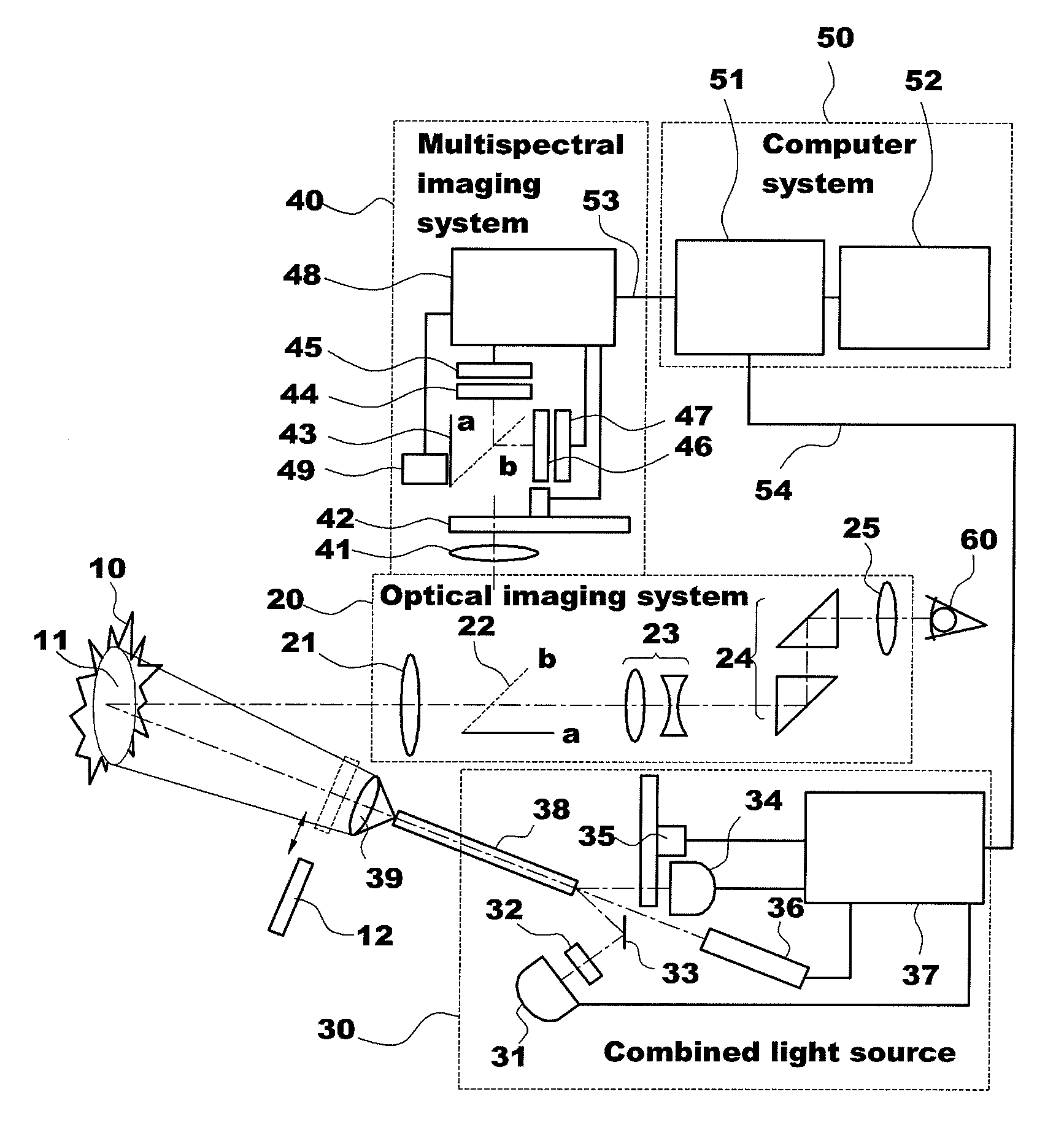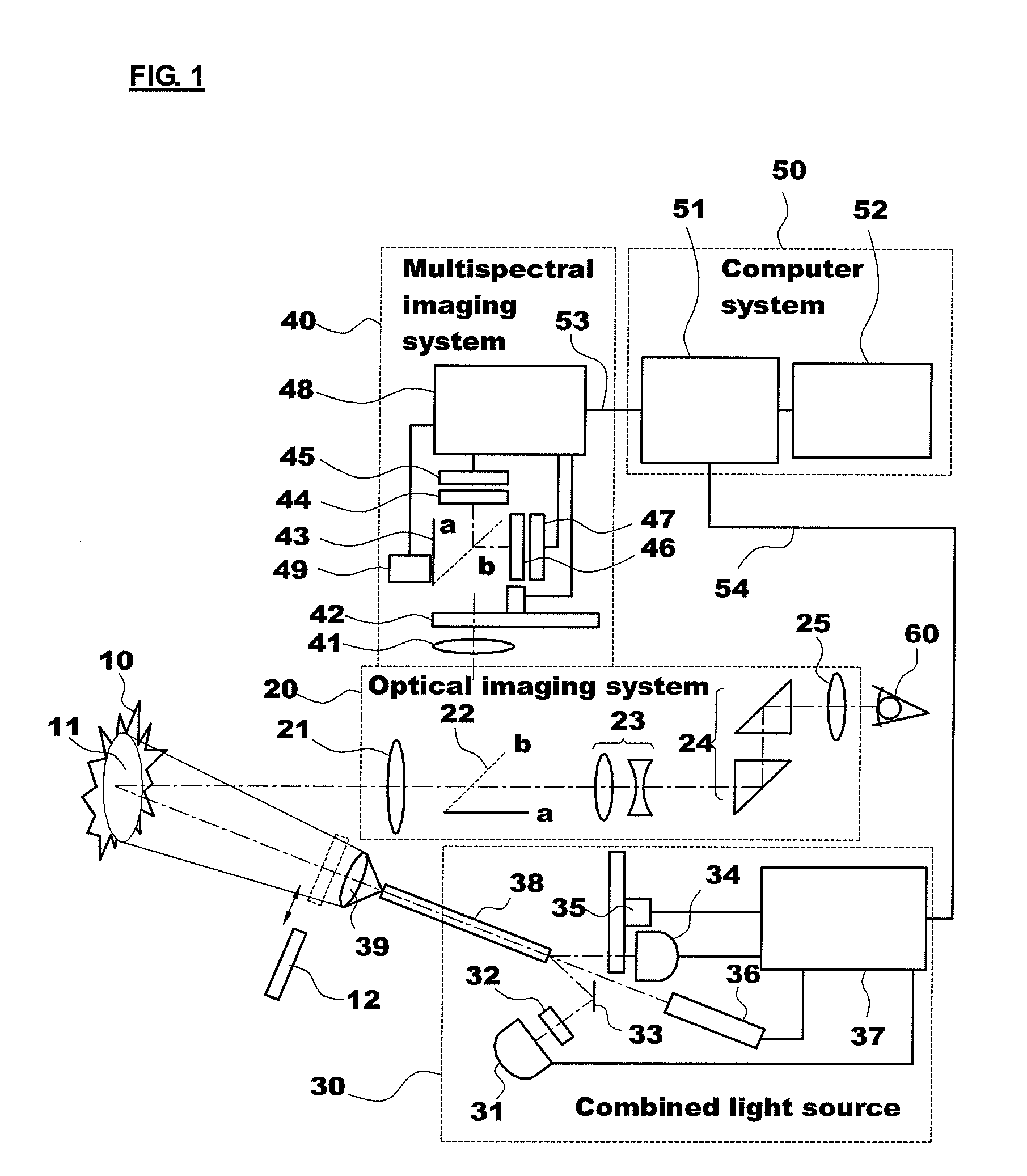Apparatus for photodynamic therapy and photodetection
a photodynamic therapy and apparatus technology, applied in the field of apparatus for photodynamic therapy and photodetection, can solve the problems of difficult operation, non-coherent white light illumination, and different illuminations of the field of view, so as to achieve effective photodetection and photodynamic therapy
- Summary
- Abstract
- Description
- Claims
- Application Information
AI Technical Summary
Benefits of technology
Problems solved by technology
Method used
Image
Examples
example 1-1
[0085]The combined light source 30 of the present invention employs the halogen lamp 31 and the mercury lamp 34 to irradiate white light to the object tissue and observe the reflectance light and defines a wideband filter having a spectral range of 400 to 700 (or 750) nm as the illumination filter wheel 35. The spectral components of the light irradiated to the object tissue can be flexibly changed by mixing the lights emitted from the mercury lamp 34 in various ratios using the first attenuator and the halogen lamp 31. In this case, the correlated color temperature varies in a range of 3,000 to 6,000 K. Spectral curves obtained from this are shown in FIG. 3. As shown in FIG. 3, when the amounts of lights from two lamps are properly complemented by each other, the spectrum is shown as a gentle and continuous curve.
[0086]The halogen lamp 31 is widely used as a colposcope light source, and a metal halide and an LED lamp may be used as the light source. Meanwhile, the reason that the c...
example 1-2
Excitation of Intrinsic Fluorescence of NADH and Flavin
[0087]In order to optimally excite these fluorescent materials, one of the excitation lights should be located in the ultraviolet region, and the other should be located at the short-wavelength side of the visible spectral region. The mercury lamp 34 with a band-pass filter (Ex1: 340±13 nm) in the illumination filter wheel 35 and the laser 36 (Ex2: 405 nm) satisfy the above conditions as the excitation light sources. The absorption wavelength bands of the two fluorescent materials are significantly different from each other, and the excitation wavelengths of the excitation light sources fall within these absorption wavelength spectral ranges, respectively (FIG. 4). In this case, the fluorescence emission spectra of the two fluorescent materials are different from each other (FIG. 7), and the fluorescence of the two fluorescent materials can be recorded by a single color detector (refer to Example 2-1 to be described below).
example 1-3
Excitation of Intrinsic Fluorescence of Flavin and PpIX
[0088]Since the light absorption wavelength ranges of the above fluorescent materials overlap in the vicinity of 400 nm, it is possible to excite the fluorescent materials at the same wavelength. However, in this case, the penetration depth of the excitation light is not so large. If the fluorescent materials are lo excited at a long-wavelength side of the light absorption spectrum of protoporphyrin IX (PpIX), the penetration depth of the excitation light is increased, which is very important in finding a tumor located in a deep part of the tissue.
[0089]FIG. 5 shows absorption spectra of the above-mentioned fluorescent materials and spectra of the two excitation light sources. In connection with the excitation conditions for flavin and PpIX fluorescence detection, the excitation light sources used in the experiment were the mercury lamp 34 with a band-pass filter (Ex1: 455±15 nm) and the laser 36 (Ex2: 635 nm). Since the outputs...
PUM
 Login to View More
Login to View More Abstract
Description
Claims
Application Information
 Login to View More
Login to View More - R&D
- Intellectual Property
- Life Sciences
- Materials
- Tech Scout
- Unparalleled Data Quality
- Higher Quality Content
- 60% Fewer Hallucinations
Browse by: Latest US Patents, China's latest patents, Technical Efficacy Thesaurus, Application Domain, Technology Topic, Popular Technical Reports.
© 2025 PatSnap. All rights reserved.Legal|Privacy policy|Modern Slavery Act Transparency Statement|Sitemap|About US| Contact US: help@patsnap.com



